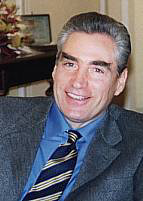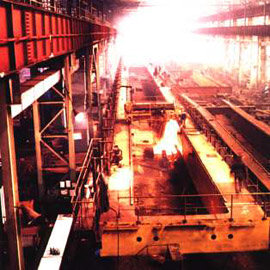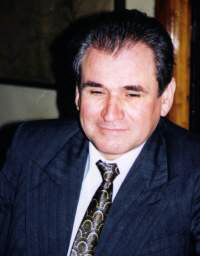
|
| |

|  Romania Romania
the awakening giant of Europe |

 Looking for lost prosperity - 1997 : A mixed performance - Rebuilding the Country - Looking for lost prosperity - 1997 : A mixed performance - Rebuilding the Country -
Major Infrastructure Projects March On - The Tough Game - No Pain, No Gain -
The Young Wolves of the Private Sector - What's Next? 
 Mixed 1997 Performance Mixed 1997 Performance
Although the new government that took office by the end of 1996 launched a fast and bold reform program which yielded very good results during the first half of 1997, later on the hidden weaknesses of the economy, as well as increasing social pressures hampered these efforts and considerably reduced the pace of the reforms. Pledging for rejuvenating the process, a wide government reshuffle took place by the end of 1997, with several rather young and dynamic technocrats taking over key positions in the cabinet. "We bear a huge responsibility before our people. We should not get into a situation where you have a successful surgery, patient dead," halfjokes the President.
The political arena was extremely restless during the first months of 1998, a major conflict between the two major parties of the ruling coalition leading to the withdrawal from the government of the five ministers and of lower level officials of the Democrat Party (PD), the junior member of the coalition. "I think that the advantage of the actual coalition is the support it enjoys from the people for the hard reform measures.

This is why we are still favorable to this coalition," saysMr. Petre Roman , PD’s leader and Romania’s first post-communist PM. The IMF's discontent regarding the current situation became pretty obvious when the fund's negotiating team left Romania by late February this year without reaching a final agreement on the economic and reform program for this year -- and consequently without approving the release of the third trench of a
$410 million package expanded over 13 months to end by mid this year. However, President Constantinescu says that the political disputes should not be a major worry for the fate of the transition process: "This is a dispute between those who want a fast reform and those who want a very fast one. It is not by chance that surrealism was born in Romania."
As for the economic fundamentals of 1997, things look twofold, with both undeniable successes and worse than expected figures.
On the dark side, inflation -- an ongoing concern for all Romanian post-communist governments -- which fell to a manageable 0.7 percent monthly rate by July 1997, bounced back to a 4.5 percent average during the next six months, fueled by not-very-wise budget-funded compensations and benefits granted to laid off people. December-to-December inflation reached 151.4 percent, way above the 90 percent target set early in the year. The GDP plummeted 6.6 percent, while the living standards fell off the cliff to their lowest level ever.
Central bank's tight monetary policy, aimed at controlling the money supply with the ultimate target of mastering inflation, almost suffocated the private small and medium-sized enterprises sector. Interest rates within the banking system skyrocketed early in the year to three digit levels. For the first time in the '90s, the private sector created unemployment, rather than jobs: over 250,000 people employed in the private sector lost their jobs in 1997. Cumulated with the wave of layoffs in the state-owned companies, unemployment reached by February this year almost 1 million people, or 9.7 percent of the workforce.
As against 1995, the service of the public debt jumped three times in real terms to $1.36 billion. This left very little maneuver room to the government for alleviating the pains of chronically under-financed sectors, like education and health.
On the bright side, the budget deficit was reduced to an estimated level of 4 percent, half of its 1996 value, primarily by cutting subsidies to the state-owned sector of the economy. State subsidies, both hidden and transparent, were halved to 14.3 percent of the state budget. The industry took the hardest hit -- subsidies plunged to one third -- while subsidies for transport andtelecommunications decreased by some 50 percent.
 | Even the agricultural subsidies were reduced by over 40 percent.
The bold reform program launched early last year stirred considerable confidence and interest among the international investment community. The stocks listed on the two local capital markets - the Bucharest Stock Exchange (BSE) and Romania's over-the-counter market
-- were the targets of massive flows of portfolio capitals. Later in the year frequent changes and legislation inconsistencies, aggravated by delays and hesitations in tackling the sensitive area of structural reforms and privatization significantly reduced the enthusiasm of portfolio investors. Yet in 1997 the Romanian capital markets yielded the best returns in the region and Wild East pioneers enjoyed in 1997 in Romania hard currency earnings as high as 250 percent! Savvy investors -- who picked, for instance, stocks within the cement and building materials, or oil industries -- made two times that buck. By March this year the total market capitalization of the stock exchange stood at some
$900 million, while the total capitalization of the OTC market exceeded $2 billion.
Foreign direct investments, although far below both necessities and potential, have also contributed to the growth of foreign capital inflows, especially during the first three quarters of 1997. A large share of these capitals were piled by the National Bank of Romania (NBR) in state's foreign currency reserve. This reserve skyrocketed in just a few months from some $600 million at the beginning of 1997 to over $2.6 billion by the end of the year - the largest amount that could be ever found in NBR's safes.
Among the most spectacular effects of this relative abundance of hard currencies was the remarkable stability of the local currency, the Leu. After in the period November
'96-February '97 the exchange rate took a deep dive -- depreciating 100 percent against the USD -- after the full liberalization of the foreign exchange market in February '97, it stabilized. A slow depreciation followed along 1997 and early 1998. By late-March the exchange rate stood at some Lei8,300/USD.
As for the restructuring of different industrial sectors, the mining industry and the agriculture were those two where most visible changes were achieved. Especially the restructuring of the coal mining (one of the most inefficient and troublesome Romanian industries) took a quick start last year, with tens of thousands of miners voluntarily leaving their jobs, attracted by the generous compensation packages, up to 20 monthly wages -- far too generous, some would say. CNLO , Romania’s largest lignite (brown coal) mining company, has virtually imploded in
1997. Its staffing level plunged from 51,000 at the beginning of the year to 21,500 to date.

Gavril Baican , CNLO’s CEO: "I consider that in 1997 our company underwent the deepest restructuring in the entire Romanian state-owned sector. It was a very complex process, but we thus managed to survive without governmental subsidies and even to show a net profit of some $5 million. It isn’t too much, but one should keep in mind that for almost 8 months we had 51,000 employees. I’m positively sure that this year we’ll do better." Unprofitable mines and quarries (CNLO produces 80 percent of its output in surface quarries) were closed; the remaining ones are quite profitable: the average production cost across the company ($12.2/ton) benchmarks pretty well against the worldwide average of $13.2/ton. Another part of the restructuring strategy was to focus only on the neighboring coal-burning power plants, in order to slash transport costs. For now, Mr. Baican can look with more hope to the future: "As soon as our financial position will strengthen, we will start an upgrading and modernization process. For instance, we have already 50 Caterpillar 30-tons lorries and we found them very competitive. Our entire IT system is based on Motorola technology." Steel and power industries will be slated for restructuring this year. The whole philosophy of state's support for the agriculture has changed. Only budgeted subsidies remained, hidden subsidies were removed, and the help was focused towards the sector of private farming, rather than on the farms still owned by the state.
|
© World INvestment NEws, 1998.
This is the electronic edition of the special country report on Romania
published in FORBES
Magazine's enriched with complementary information,
such as full interviews, detailed company files and more.
June 1 st 1998 issue
Developed by AgenciaE.Tv |
|
|
|
| |
| | | |
|

